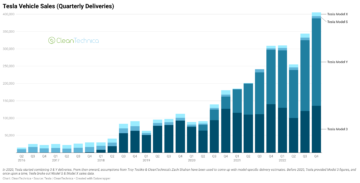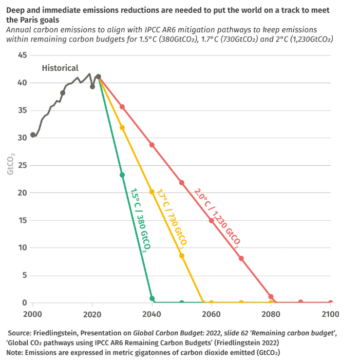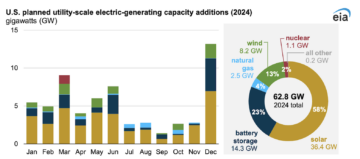Sign up for daily news updates from CleanTechnica on email. Or follow us on Google News!
[Editor’s note: After reading Dave Reichmuth’s most recent piece, I started thinking about a comparable study on Wisconsin land use. Land use and solar power, which generates clean electricity that many increasingly use to power EVs and homes, are topics of complaints we hear from time to time. However, a thorough analysis demonstrated that we currently use a lot of land to make corn ethanol. Acre by acre, solar wins — substantially and sustainably more electricity. The study proves the absurdity of that particular complaint with regards to solar (up to a 200× difference compared to corn ethanol). See: “Corn Ethanol vs. Solar: A Land Use Comparison.”
Article by Dave Reichmuth.
Replacing gasoline with electricity greatly reduces the carbon emissions from driving. Based on where electric vehicles (EVs) have been sold, driving the average EV in the US produces global warming emissions equal to a hypothetical 94 mile per gallon gasoline car, or less than a third of the emissions of the average new gasoline car.
Transportation is the largest sector for emissions, and passenger cars, trucks, and SUVs are the majority of transportation emissions, so there is no way to slow down climate change without a fundamental shift from petroleum to clean electricity to power our vehicles.
When UCS first compared driving an EV to a gasoline car, only 45 percent of the country lived where driving an EV was better than a 50 mpg gasoline car. Now, 93 percent of the country lives where the average EV is better than the most efficient gasoline vehicle (57 mpg). And for the first time, we find that for everyone in the US, driving the most efficient EV produces less global warming emissions than any gasoline-only vehicle available (including non-plug-in hybrids).
EV emissions depend on source of electricity
The emissions from driving an EV depend on where the electricity comes from to recharge it, and that depends on where in the country you’re recharging. In places with a relatively clean grid, emissions from driving an EV are very low. For example, driving an EV in upstate NY is equal to an 219 mpg gasoline car, or less than 12 percent of the average new gasoline vehicle emissions.
Even where the grid still has significant fossil fuel-powered generation, EVs are a cleaner choice. In the grid region that serves most of Texas, driving the average EV produces emissions equal to an 82 mpg gasoline car, despite over 60% of electricity generation coming from fossil fuels.

EVs are responsible for less than half the global warming pollution of gasoline cars, even when including emissions from manufacturing.
Manufacturing an EV results in more global warming emissions than manufacturing a comparable gasoline vehicle. This is chiefly due to the energy and materials required to produce an EV’s battery. However, most of the global warming emissions over the lifespan of today’s vehicles occur during use, so the reductions from driving an EV more than offset the higher manufacturing emissions. Our most recent analysis of manufacturing emissions compared the average gasoline sedan (32 mpg) to the average-efficiency EV car with a 300-mile-range battery. We found that the EV reduces total lifetime emissions 52 percent and an EV pickup truck reduces lifetime emissions 57 percent compared with the average gasoline pickup.
Choosing a more efficient EV can offset charging on dirtier power
EVs vary in efficiency, with the most efficient EVs going more than 4 miles on one kilowatt-hour of electricity while some electric pickup trucks get less than 2 miles of driving on the same amount of energy. Choosing a more efficient EV that meets your driving needs will reduce the emissions from driving. For example, charging the average EV on Florida’s grid means effective emissions equal to 75 mpg in a gasoline car, while choosing an EV like the Hyundai Ioniq 6 can reduce emissions to that of a 98 mpg conventional vehicle. And of course, a more efficient EV will also cost less to recharge.

Electrifying larger vehicles like pickups can also reduce emissions
Using an electric pickup truck in the place of a gasoline truck can have clear emissions benefits; on the grid that covers most of Texas, using an electric pickup truck can have emissions equal to a 2024 Toyota Prius XLE. However, switching from an efficient gasoline car to an electric truck means reducing or eliminating the climate benefit of electrification. Drivers that are looking to lower their emissions and fuel bill should choose electric vehicles over gasoline vehicles but also choose the most efficient vehicle that meets their transportation needs.

Emissions from electricity generation (and for using EVs) have dropped dramatically
The first UCS analysis of the emissions from EV driving in 2012 showed promise for EVs, but the emissions for some parts of the country were equal to the efficient non-hybrid gasoline cars of the time. In the 2012 analysis, only 45% of the country lived where driving an EV was better than a 50 mpg gasoline car. In this most recent analysis, that number has skyrocketed to 93% of the country living where the average EV is better than the most efficient gasoline vehicle (57 mpg). And for everyone in the US, driving the most efficient EV produces less global warming emissions than any gasoline-only vehicle available (including non-plug-in hybrids).
This reduction in EV emissions has come largely from the increased use of clean energy sources like wind and solar and the marked reduction in coal-fired power generation. In the 2012 analysis (using 2009 electricity generation data), 44% of electricity in the US was generated using coal and less than 2% was from wind and utility-scale solar. By 2022, coal generation dropped by more than half, to less than 20%, while wind and solar rose to 14%, and 39% of all generation was from non-fossil fuel sources. As the grid continues to get cleaner, charging EVs will also get cleaner, making both used and new EVs better choices for slowing climate change.
Driving on electricity is better for trips that require a car
Switching from gasoline to electricity means significant reductions in climate-changing emissions and this transition is a necessary step to avoid the worst impacts of climate change. But the emissions savings from not driving altogether are even higher. Replacing driving with public transit or e-bikes can greatly reduce emissions. And walking or using a traditional bike means avoiding air pollution and climate-changing emissions altogether. With our current transportation system, it’s difficult for many people to switch all of their trips to transit, walking, or biking, but using these modes even part of the time can make a positive difference in the pollution from personal transportation.
Notes on calculations
The analysis presented in this blog uses the methods detailed in the 2022 report “Driving Cleaner”, with the following modifications:
- The data source for electricity generation was updated to EPA’s eGRID2022 data (released in January 2024).
- Upstream emissions factors now use the GREET2023 database from Argonne National Laboratory.
- Small-scale solar (residential and commercial) that is not included in eGRID has been estimated using the state-level data from the Energy Information Agency’s Electric Power Monthly (table 1.17B) report for calendar year 2023 and allocated to grid subregions using population-weighted averages based on EPA’s ZIP code subregion assignments.
- The average EV efficiency and location of EV sales (for the sales-weighted national emissions estimate) has been updated to reflect EV sales from 2018 through 2023 based on data from Atlas Public Policy.
The Equation, Union of Concerned Scientists
Have a tip for CleanTechnica? Want to advertise? Want to suggest a guest for our CleanTech Talk podcast? Contact us here.
Latest CleanTechnica.TV Videos
[embedded content]
[embedded content]
Advertisement
CleanTechnica uses affiliate links. See our policy here.
- SEO Powered Content & PR Distribution. Get Amplified Today.
- PlatoData.Network Vertical Generative Ai. Empower Yourself. Access Here.
- PlatoAiStream. Web3 Intelligence. Knowledge Amplified. Access Here.
- PlatoESG. Carbon, CleanTech, Energy, Environment, Solar, Waste Management. Access Here.
- PlatoHealth. Biotech and Clinical Trials Intelligence. Access Here.
- Source: https://cleantechnica.com/2024/06/02/driving-on-electricity-is-now-much-cleaner-than-using-a-gasoline-car/
- :has
- :is
- :not
- :where
- $UP
- 1
- 12
- 2%
- 2009
- 2012
- 2018
- 2022
- 2023
- 2024
- 32
- 37
- 4
- 400
- 45
- 50
- 52
- 6
- 75
- 900
- 98
- a
- About
- acre
- Advertise
- Affiliate
- After
- AIR
- Air pollution
- All
- allocated
- also
- alt
- altogether
- amount
- an
- analysis
- and
- any
- ARE
- Argonne National Laboratory
- AS
- available
- average
- avoid
- avoiding
- based
- battery
- been
- benefit
- benefits
- Better
- Bill
- Blog
- both
- but
- by
- Calendar
- CAN
- car
- carbon
- carbon emissions
- cars
- change
- charging
- choice
- choices
- Choose
- choosing
- clean
- clean energy
- cleaner
- cleantech
- Cleantech Talk
- clear
- Climate
- Climate change
- Coal
- code
- come
- comes
- coming
- commercial
- comparable
- compared
- complaint
- complaints
- concerned
- content
- continues
- conventional
- Cost
- country
- course
- covers
- Current
- Currently
- data
- Database
- Dave
- demonstrated
- depend
- depends
- Despite
- detailed
- diesel
- difference
- difficult
- down
- drivers
- driving
- dropped
- due
- during
- Effective
- efficiency
- efficient
- EIA
- Electric
- electric vehicles
- electricity
- electrification
- eliminating
- embedded
- Emissions
- energy
- EPA
- equal
- estimate
- estimated
- EV
- Even
- Every
- everyone
- evs
- example
- factors
- fewer
- Find
- First
- first time
- following
- For
- fossil
- fossil fuels
- found
- from
- Fuel
- fuels
- fundamental
- GAS
- gasoline
- generated
- generates
- generation
- get
- Global
- global warming
- going
- greatly
- Grid
- Guest
- Half
- Have
- hear
- higher
- Homes
- However
- HTTPS
- Hybrid
- Hyundai
- i
- Impacts
- in
- included
- Including
- increased
- increasingly
- information
- IT
- January
- laboratory
- Land
- largely
- larger
- largest
- less
- less than 20%
- lifespan
- lifetime
- like
- links
- Lives
- living
- location
- looking
- Low
- lower
- lucid
- Majority
- make
- Making
- manufacturing
- many
- many people
- marked
- materials
- Matter
- max-width
- mean
- means
- Meets
- methods
- mile
- modes
- Modifications
- more
- more efficient
- most
- moving
- much
- National
- nearly
- necessary
- needs
- net
- New
- news
- no
- note
- now
- number
- NY
- occur
- of
- offset
- on
- ONE
- only
- or
- our
- over
- part
- particular
- parts
- People
- per
- percent
- personal
- Petroleum
- Pickup
- piece
- Place
- Places
- plato
- Plato Data Intelligence
- PlatoData
- player
- podcast
- policy
- Pollution
- positive
- power
- presented
- produce
- produces
- promise
- proves
- public
- public transit
- Reading
- recent
- Recharge
- reduce
- reduces
- reducing
- reduction
- reductions
- reflect
- regards
- region
- relatively
- released
- report
- require
- required
- residential
- responsible
- Results
- ROSE
- sales
- same
- Savings
- sector
- see
- serves
- shift
- should
- showed
- significant
- slow
- Slowing
- So
- solar
- Solar Power
- sold
- some
- Source
- Sources
- started
- Step
- Still
- Study
- substantially
- such
- suggest
- sustainably
- SUVs
- Switch
- system
- table
- Talk
- texas
- than
- that
- The
- their
- There.
- These
- Thinking
- Third
- this
- thorough
- Through
- time
- tip
- to
- today’s
- Topics
- Total
- toyota
- traditional
- transit
- transition
- transportation
- truck
- Trucks
- tv
- union
- updated
- Updates
- us
- use
- used
- uses
- using
- vary
- vehicle
- Vehicles
- very
- Video
- vs
- walking
- want
- was
- Way..
- we
- webp
- were
- when
- which
- while
- will
- wind
- Wins
- Wisconsin
- with
- without
- Worst
- year
- you
- Your
- youtube
- zephyrnet
- Zip











